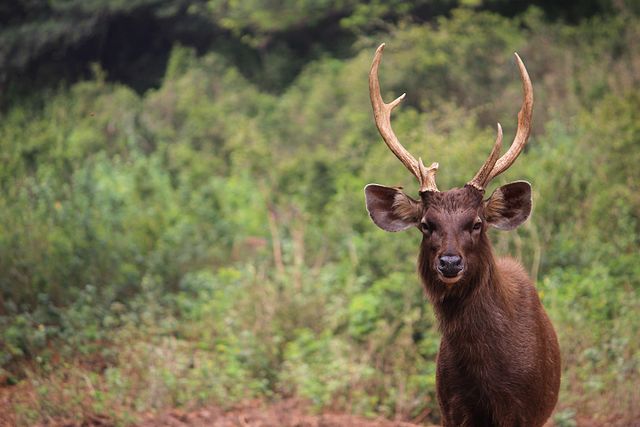 |
| Indian Wild Deer |
- Cold Weather Season (Winter): December to February - Temperature is quite low in the northern part of India.
- Hot Weather Season (Summer): March to May - Temperature is quite high. Loo is the common feature of this season.
- Southwest Monsoon Season (Rainy): June to September - Marked by the onset of monsoon winds. These winds carry moisture with them and on striking the mountains, causes rain.
- Retreating Monsoon Season (Autumn): October and November - Marked by the retreat of monsoon. In this season, southern states such as Tamil Nadu, Telangana and Andhra Pradesh receives the rainfall. This rainfall is beneficial for crops such as mango and coffee. Therefore these rains are also called Mango showers.
Climate of India
- The climate of any place depends upon its location, altitude, distance from sea and relief.
- The climate of India has been mostly described as Monsoon type.
- Agriculture in India is heavily dependent on Monsoon rains.
- Mawsynram in Meghalaya receives world largest rainfall.
Natural Vegetation
India has a wide array of natural vegetation. The natural vegetation of India can be divided as 1. Tropical evergreen forest, 2. Tropical deciduous forest, 3. Thorny bushes, 4. Mountain vegetation and 5. Mangrove forests.
Tropical Rain Forests
- They occur in the area of heavy rainfall.
- They are dense and sometimes sunlight does not even reach the ground.
- They are home to several species of trees which sheds leaves at different times of the year. Therefore, they always appear green and known as evergreen forests.
- Mahogany, ebony and rosewood are some of the important trees found in these forests.
- These forests are found in Andaman and Nicobar Islands, part of Northeast states and Western Ghats of India.
Tropical Deciduous Forests
- They are a less dense forest than the tropical rain forest.
- They are dependent on monsoon for their water needs. Therefore, they are also known as Monsoon Forests.
- They shed their leaves at one particular time of the year.
- Sal, teak, peepal, neem and shisham are the prominent trees of these forests.
- They can found in the states of Madhya Pradesh, Uttar Pradesh, Bihar, Jharkhand, Chhattisgarh, Odisha and Maharashtra.
Thorny Bushes
- This type of vegetation is a feature of dry regions.
- Cactus, khair, babool and keekar are the prime examples of this type of vegetation,
- It can be found in the state of Rajasthan, Punjab, Haryana, Eastern slopes of Western Ghats and Gujarat.
Mountain Vegetation
- A variety of species can be found in mountain regions. The variedness is characterized by the increase in height of the terrain.
- At height between 1500 and 2500, most of the trees are conical in shape. Henceforth, these are known as coniferous trees.
- The prime examples of mountain vegetation are Pine, Chir and Deodar.
Mangrove Forests
The Mangrove vegetation can withstand in saline water and mostly found in the coastal areas.
Sundari is the prime example of this type of vegetation. Sunderbans gets its name from this tree.
Why Are Forest Necessary?
- Forests perform a variety of functions. They provide us with oxygen to breathe and control soil erosion. Along with these things, they provide us with timber, fuelwood, fodder, medicinal plants, lac, honey and gum.
- Due to the reckless cutting of the forest, we can see the deteriorating effects of depleting forest cover on the environment.
- Forests are also home to numerous wildlife.
- Tiger (Sunderbans), Asiatic lion (Gir Forest), Elephants (Assam, Kerala, Karnataka), Rhinoceros (Assam), Camels and Wild asses (Rajasthan and Gujarat), Wild Goats, Bears and Snow Leopard (Himalayan Region).
- Due to the mindless cutting of forest and demand for animal body parts, several wildlife species are declining rapidly. Some of them have become extinct. In order to save them, the Government of India has come up with several wildlife projects such as Project Tiger, Project Hangul, Project Elephant and others to save them.
- The Government of India has designated several areas such as wildlife sanctuaries, national parks and biosphere reserves to protect these species.
